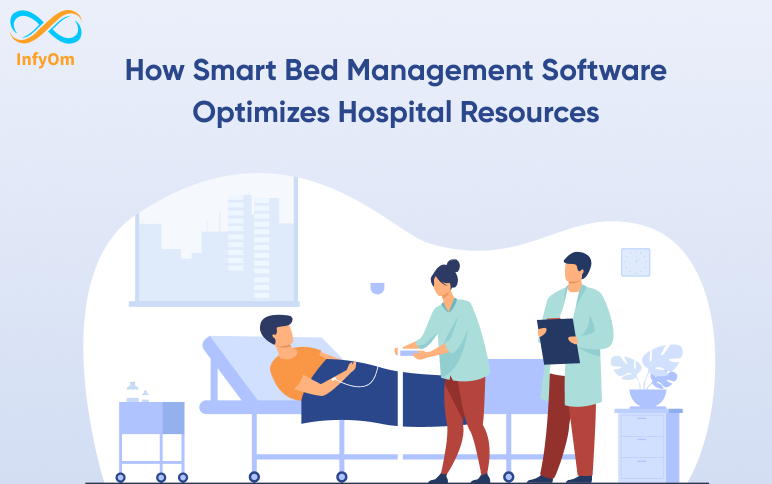Hospital inventory is a complex and important part of healthcare delivery. As healthcare systems face increasing pressures due to increasing patient volumes and limited resources, there is a need for better management. The COVID-19 pandemic continues to highlight these challenges, as this crisis has led to an unprecedented rise in patient volumes and hospitals around the world lack the necessary resources to indicate the need for new solutions, increase resources and maintain high- quality patient care. One of the most promising technological improvements in this area is the wise bed control software program. In this post we will discover how smart bed control software optimises hospital resources, enhancing patient care, lowering charges, and enhancing operational performance.
What is Smart Bed Management Software?
Smart Bed Management Software is a virtual solution made to optimise the process for conducting health facility beds. By integrating actual-time records, predictive analytics, and communication gear, SBMS provides hospital administrators, clinicians, and support staff with a comprehensive view of bed availability, patient reputation, and resource allocation. This integration of era facilitates extra informed selection-making, complements affected person safety, and optimises resource utilisation.
Key Features of Smart Bed Management Software
Smart Bed Management Software revolutionises how hospitals manage their resources, making patient care more efficient and streamlined. Let’s discuss these features in details:
1. Real-time Bed monitoring:
SBMS provides accurate and up-to-date information about bed availability, allowing staff to make informed decisions about patient admissions, transfers, and discharges.
2. Predictive Analytics:
Advanced algorithms analyse patient flow patterns and predict future bed demand, enabling hospitals to plan for changes in patient volume and optimise resource allocation
3. Automated Alerts and Notifications:
The software creates alerts to assist in bed status, patient event changes and discharge notifications; thus facilitating better communication between hospital staff leading to a reduction in the time taken for care of patients.
4. Electronic health record integration:
SBMS integrates smoothly to EHR systems, centralising a patient view and enhancing the care management.
5. Dashboards and Reports:
Customise dashboards that display key performance data like bed occupancy rate, length of stay and patient turnover.
6. Resource Optimization:
Based on bed occupancy, patient flow and staffing data from all departments being managed centrally through SBMS envisage in redistributing resources to reduce wastages while improving efficiency.
Benefits of Smart Bed Management Software
The Smart Bed Management Software presents a lot of advantages to not just the hospitals but also for patients and regulated as well. Benefits like better patient outcomes, higher operational efficiency and optimised resource utilisation.
1. Improved Patient Flow and Reduced Wait Times
One of the major benefits of SBMS is improved patient flow to hospitals. By providing real-time information about bed availability and patient status, the software enables staff to quickly make informed decisions about admission, transfer and discharge of patients clinical These services reduce patient wait times, ensure timely access to care, and improve their overall experience.
2. Increased Staff Efficiency and Collaboration
It allows the face-to-face communication of hospital staff and gathers it into one solution The SBMS unites to share knowledge within bed availability, patient status information as well discharge instructions. This integrated approach eliminates the burden of time-consuming manual procedures, and increases staff productivity. Also, automated alerts and notifications enable the staff to prioritise tasks so that patients are treated quickly.
3. Increased Resource Utilisation and Reduced Costs
Based on bed occupancy, patient flow and staff availability data SBMS provides hospitals with the basis for optimised resources allocation minimising waste as well making resource utilisation more efficient. Bed management can be a strategic priority for hospitals looking to reduce operational costs and improve financial performance.
Cost Reduction Example – Hospitals implementing SBMS have reported significant cost savings by reducing unnecessary hospital stays, minimising patient transfers, and optimising staff scheduling. These savings can be reinvested in improving patient care and expanding hospital services.
4. Improved Patient Safety and Quality of Care
By automating the bed management process, SBMS leads to the reduction in manual errors that contribute towards patient safety. The software provides accurate and up-to-date information about patient status, allowing staff to make informed decisions about patient care. Inclusion of SBMS into EHR systems also makes patient information easily accessible, which helps in improving the quality and continuity of care by offering streamlined coordination among care teams.
Patient Safety Improvement – Source: Incorporating the SBMS was linked to a 15% decrease in adverse bed management-related incidents as reported by Journal of Patient Safety on one study and demonstrated that technology plays a vital role for patient safety.
5. Data-Driven Decision-Making
The dashboards and reporting features of SBMS offers hospital administrators a series of dashboards that provide visibility into core metrics like bed occupancy rates, avg length of stay and patient turnover. This allows the hospitals to then use this data for making decisions on resource allocation, staffing and process improvements. Our data science enables hospitals to track trends, site challenges and improve continuously.
Challenges and Considerations in Implementing SBMS
Although the rewards for Smart Bed Management Software are high, what about hospitals facing difficulties in its deployment. Addressing these challenges is crucial for successful adoption and resource optimization in hospitals.
1. Integration with Existing Systems
Integrating SBMS with traditional hospital systems, for instance Ehrs and patient management software etc. is a major headache to manage the task in complex. Hospitals must ensure that the software is compatible with their existing infrastructure and can smoothly be integrated into other systems to gather a 360-degree view of patient information together.
Solution: Custom Integration Services – Hospitals can easily struggle with compatibility, but a custom integration service offered by seasoned companies will facilitate the process and ensure seamless transition to SBMS.
2. Staff Training and Adoption
Successfully implementing SBMS requires buy-in and adoption from hospital staff. Training staff to use the software effectively and addressing any concerns or resistance to change is crucial for successful implementation.
Solution: Comprehensive Training Programs – Hospitals need to have robust training programs in place that integrate the software into a hospital environment and show staff how it can help them. Continued support and feedback processes can also help the staff in adapting to it at a rolling base while potentially improving usage.
3. Data Privacy and Security
Hospitals take the security of patient data very seriously, which means that there are concerns to be addressed around privacy and ensuring all safeguards have been put in place. Hospitals need to make sure that the software is in regulation with protecting patient information.
Solution: Strong Security Measures – Hospitals and SBMS vendors should work together to take steps for each organisation’s benefit — hospitals, in the interest of patient information protection and compliance with regulations; vendors.
4. Cost and ROI
For hospitals, and particularly those with more limited budgets, upfront cost can be a concern in the first instance of implementing SBMS. The initial investment however, can be significantly low compared to the long term benefits and cost savings linked with enhanced efficiency and resource utilisation.
Solution: ROI Analysis – Doing a broad institutional ROI analysis would be necessary for hospitals to assess the question of whether SBMS pays itself off in the long run. Drawing attention to the potential cost savings and patient health benefits can justify funding implementation.
The Future of Smart Bed Management Software
As healthcare technology continues to evolve, the capabilities of Smart Bed Management Software are expected to expand, offering even greater benefits to hospitals and patients. Some trends and advancements in SBMS include:
1. Integration with Artificial Intelligence
By combining AI with SBMS, the predictive analytics function is strengthened and hospitals can benefit from having more accurate bed demand forecasts as well as patient flow. Artificial intelligence-based algorithms can assess large volumes of complex data, identify trends and suggest where resources should best be allocated.
2. Internet of Things Integration (IOT)
The Internet of Things plays an important role in improving SBMS by providing hospital bed and patient condition real time monitoring opportunities. By making bed occupancy, patient movement and environmental conditions available to a hospital data warehouse these IoT devices can be used by hospitals for insights that might help improve resource utilisation.
3. Enhanced Patient Engagement
SBMS may incorporate additional features that promote patient engagement in the future, such as mobile apps enabling patients to follow their care progress and communicate with healthcare providers. Such features can enhance patient satisfaction and foster engagement in their journey of care.
4. Telehealth and Remote Monitoring Integration
As telehealth and remote monitoring become more prevalent, SBMS can integrate these technologies to provide a seamless patient care experience. This integration can enhance care coordination, improve patient outcomes, and optimise resource utilisation.
Conclusion
Smart Bed Management Software; an efficient mechanism to better manage resources in a hospital, to increase throughput and keep the patients happy. SBMS achieves this through leveraging real-time data, predictive analytics and communication tools to provide efficient patient flow management, improved staff performance and optimised resource utilisation. With solutions like InfyHMS, such benefits are made real where hospitals can blend these technologies with their operational workflow. Although this can seem to be a lot of work, it is worth it for the long-term improvements in patient care and operational performance that SBMS provides hospitals. The more technology advances, the higher SBMS potential will be, to allow hospitals better save on their dedicated resources and offer world-class patient care.



